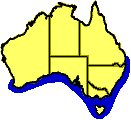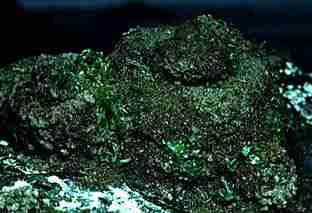|
|

Cunjevoi, Pyura stolonifera
Form:
The Cunjevoi's shape is squat and globular. It has a thick, leathery outer covering, called a test or tunic, which is often obscured by algae. The cunjevoi has a cylinder-shaped body with two openings called siphons.
Colour:
Sea squirts are brown in colour. They are often covered with green algae. Fishermen often cut the cunjevoi open, using the red flesh as bait.
Phylum: |
Chordata |
Author: |
Heller, 1878 |
Family: |
Pyuridae |
Size: |
150 mm high; 80 mm across |
Distribution:
 Cunjevoi
ranges from southern Queensland, New South Wales, eastern and central
Victoria, South Australia and Western Australia.
Cunjevoi
ranges from southern Queensland, New South Wales, eastern and central
Victoria, South Australia and Western Australia.
Habitat:
Cunjevoi is found in large groupings low on the shore at and below low-tide level, attached to rock.
Biology:
Cunjevoi is an ascidian which belong to the group protochordates.
Although the adults do not have a vertebral column, their free-swimming larvae have a notochord (precursor of vertebrae), a dorsal nerve chord, and gill slits.
When the free-swimming "tadpole-like" larvae detects adult cunjevoi using chemical sensors, it swims around looking for a place to attach. It has two "cement-glands" on its head. It sticks its head down onto the rock surface and then begins to metamorphose and grow into the adult sessile form. Bennett gives an excellent description of what occurs on page 372.
Adult cunjevoi feed on plankton and exchange gasses by sweeping water in through the buccal siphon by beating cilia. Inside the test, as the water passes the pharynx, plankton is filtered out and moved to the stomach. Respiratory gasses are exchanged with oxygen absorbed from the water, and carbon dioxide removed. Water passes out of the ascidian through the atrial siphon.
The name sea-squirt comes from the ability to spray a jet of water into the air when disturbed.
References:
Bennett, I. (1987) W.J. Dakin's classic study: Australian Seashores. p.372, Angus & Robertson, Sydney.
Davey, K. (1998) A Photographic Guide to Seashore Life of Australia. p. 136, New Holland, Sydney.
Edgar, G.J. (1997) Australian Marine Life: the plants and animals of temperate waters. p.379, Reed Books, Kew.
Quinn, G.P., Wescott, G.C. & Synnot, R.N. (1992) Life on the Rocky Shores of South-Eastern Australia: an illustrated field guide. p.85, Victorian National Parks Association, Melbourne.
Marine Research Group of Victoria (1984) Coastal Invertebrates of Victoria: an atlas of selected species. p.156, Museum of Victoria, Melbourne.
Underwood, A.J. & Chapman, M.G. (1993) Seashores: a beachcomber's guide. p.34, New South Wales University Press, Sydney.
Chordata
Ascidians
Home
Page
Taxonomy
Biogeography
Rocky Shores
Tidal Levels
Intertidal Zonation
Environmental Factors
Biological
Factors
Feeding Relationships
Activities
Glossary
References
 Life
on Australian Seashores
Life
on Australian Seashores
by Keith Davey (C) 2000
Learning Consultant
- Media
The University of Newcastle
email at australian_seashores@hotmail.com
Scientific Consultant: Phil
Colman
site created 01.01.98 : updated 01.04.2000
